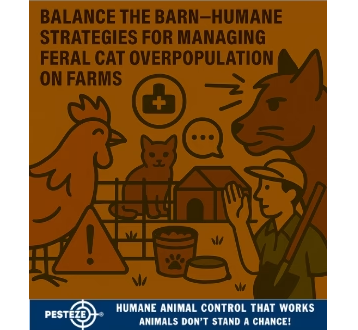MANAGING OVERPOPULATION OF FERAL CATS ON FARMS

MANAGING OVERPOPULATION OF FERAL CATS ON FARMS
SUMMARY
Feral cats can help control rodent populations on farms, but unchecked growth leads to disease, resource strain, and ecological disruption. This guide outlines humane, effective methods to manage feral cat colonies, protect livestock, and maintain a healthy balance between animal welfare and farm sustainability.
FEATURES
-
Implement Trap-Neuter-Return (TNR): Prevent breeding by trapping, sterilizing, and returning cats to their territory.
-
Establish Managed Colonies: Create designated feeding stations and shelters to monitor health and numbers.
-
Promote Targeted Adoption: Socialize kittens and adopt out friendly cats to reduce colony size.
-
Educate the Community: Share resources and best practices with neighbors to prevent abandonment and support TNR.
-
Partner with Vets and Shelters: Access low-cost spay/neuter services and medical care for feral cats.
-
Monitor and Maintain: Track colony members, remove sick or injured cats, and adjust care as needed.
GUIDE DESCRIPTION
Feral cats are a common sight on farms, often welcomed for their rodent-hunting skills. But when populations grow unchecked, they can spread disease, compete with livestock for resources, and disrupt local ecosystems. Managing feral cat overpopulation requires a compassionate, strategic approach.
The most effective method is Trap-Neuter-Return (TNR). This involves humanely trapping feral cats, sterilizing and vaccinating them, and returning them to their territory. TNR halts the breeding cycle, reduces nuisance behaviors, and stabilizes colony size over time.
Managed colonies are key to long-term success. Set up feeding stations and shelters in discreet areas to monitor health and numbers. Regular feeding discourages roaming, while shelters offer protection from weather and predators. Colony caretakers should perform routine health checks and report concerns.
Targeted adoption helps reduce colony size. Young kittens and friendly adults can be socialized and placed in homes. This not only lowers the population but also improves outcomes for individual cats.
Community education is essential. Many feral cats are abandoned pets or offspring of unsterilized animals. Sharing TNR resources, promoting responsible pet ownership, and discouraging abandonment can prevent future overpopulation.
Veterinary partnerships make humane care possible. Many clinics offer discounted spay/neuter services for feral cats. Vaccinations and treatment for injuries or illness improve welfare and reduce disease transmission.
Ongoing monitoring ensures success. Keep records of colony members, remove sick or injured cats, and adjust feeding or shelter setups as needed. A well-managed colony benefits the farm, the cats, and the surrounding environment.
- Amy Chang


Comments 0